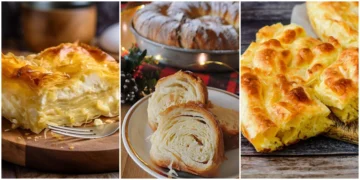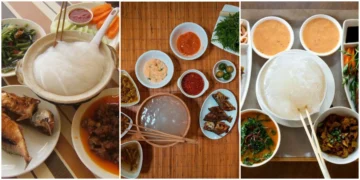El Salvador—a small Central American nation known for its warm “pura vida” spirit, vibrant culture, and rich agricultural traditions—is celebrated as a culinary icon that stands out as the best food of El Salvador: Pupusas. These stuffed corn tortillas, filled with savory ingredients and traditionally served with curtido and salsa roja, are not only a staple of Salvadoran cuisine but also a symbol of the nation’s resilience and creativity. More than just a meal, pupusas represent a shared cultural identity—a dish born of humble ingredients that have evolved into a national treasure, enjoyed at family gatherings, festive events, and street food stalls throughout the country.
Why Pupusas Are the Best Food of El Salvador?

Pupusas have earned their reputation as the best food in El Salvador because they embody the ingenuity of Salvadoran home cooking. At first glance, a pupusa appears simple—a soft, warm tortilla made of corn masa, generously stuffed with fillings that range from cheese and refried beans to chicharrón (fried pork) or a mix of ingredients. However, with each bite, the pupusa reveals a complexity of flavors and textures: the slightly crispy exterior of the tortilla contrasts beautifully with the gooey, savory filling, while the tangy curtido and the vibrant salsa add freshness and balance to the dish.
This culinary masterpiece is a reflection of El Salvador’s resourcefulness. Pupusas were originally created as a way to maximize the use of locally available ingredients, turning corn—the cornerstone of the Salvadoran diet—into an everyday comfort food that could feed large families on a modest budget. Today, they are a source of national pride, a dish that embodies the flavors, traditions, and communal ethos of the Salvadoran people.
Key Ingredients of Pupusas (Best Food of El Salvador)
- Corn Masa: The base of every pupusa is made from corn masa, a dough prepared from finely ground nixtamalized corn. This process, which involves soaking and cooking corn kernels in an alkaline solution (typically lime water), not only enhances the nutritional profile of the corn but also imparts a distinctive flavor and smooth texture to the dough.
- Fillings: Pupusas are incredibly versatile when it comes to fillings. Traditional options include:
- Queso (Cheese): A soft, mild cheese that melts into a creamy, gooey center.
- Frijoles (Refried Beans): Seasoned and mashed beans that provide an earthy, hearty element.
- Chicharrón (Fried Pork): Crisp, flavorful pork that adds a savory, slightly smoky depth.
- Combination: Many pupusas feature a mixture of the above ingredients, balancing creaminess, earthiness, and savory crunch.
- Curtido: This lightly fermented cabbage slaw, mixed with carrots, onions, and a hint of oregano, is essential. It adds a bright, tangy contrast that cuts through the richness of the pupusa.
- Salsa Roja: A vibrant tomato-based sauce spiced with garlic, chili, and vinegar, salsa roja ties all the flavors together, adding a burst of acidity and heat that enhances each bite.
- Seasonings: Salt and occasionally a dash of other spices, such as cumin or paprika, are added to both the masa and the fillings.
Prepare Pupusas (Best Food of El Salvador)

-
Preparing the Corn Masa: The process begins with the mixing of corn masa with water and a pinch of salt. This dough is kneaded until it reaches a smooth, pliable consistency. The nixtamalization process used to prepare the corn not only enriches the flavor but also improves the dough’s texture.
-
Forming the Pupusas: Small portions of the masa are taken and flattened into a disc. A spoonful of the chosen filling—whether cheese, refried beans, chicharrón, or a combination thereof—is placed in the center. The masa is then carefully folded around the filling, sealing it inside. The ball is gently flattened again to form a thick, round patty. The process requires a delicate balance: too thin, and the pupusa may tear; too thick, and the interior may not heat evenly.
-
Cooking: Traditionally, pupusas are cooked on a griddle or comal over medium-high heat. The pupusas are placed on the griddle and cooked for several minutes on each side until a light, golden crust forms. This searing locks in the moisture of the fillings while creating a slightly crispy exterior.
-
Serving: Once cooked, the pupusas are typically served hot, then accompanied by curtido and a side of salsa roja. The combination of warm, freshly made pupusas with the tangy slaw and spicy sauce creates a dynamic and satisfying meal.
What Makes Pupusas Unique?
Pupusas are unique in their simplicity and versatility. The beauty of a pupusa lies in its humble ingredients and the artisanal care with which it is prepared. The combination of freshly made corn masa, savory fillings, and the essential accompaniments of curtido and salsa roja. It creates a complete meal that is both nutritious and comforting.
Furthermore, pupusas are a reflection of Salvadoran culture. They are deeply embedded in the nation’s identity, celebrated in festivals, family gatherings, and daily meals alike. The tradition of making pupusas is a communal activity, often involving multiple generations. It reinforces the social fabric and the shared heritage of the Salvadoran people.
History of Pupusas (Best Food of El Salvador)

The origins of pupusas can be traced back to the pre-Columbian era in Central America, where corn was a staple crop and played a crucial role in the diet of indigenous peoples. Over time, as Spanish colonial influences merged with local traditions, the pupusa evolved into a dish that was both nourishing and versatile. Originally a meal for the working class, pupusas were designed to be filling and affordable. It provides a complete nutritional profile that could sustain laborers through long days in the fields.
Throughout the centuries, pupusas have become an integral part of Salvadoran culture. They were traditionally prepared in large batches to feed communities during festivals and celebrations. The recipe was refined over generations to achieve the perfect balance of flavor and texture. Today, pupusas are not only a culinary delight but also a proud symbol of Salvadoran resilience and creativity. It is a dish that connects modern Salvadorans to their ancestral roots.
Other Authentic Delicacies from El Salvador
- Yuca Frita: Crispy fried cassava served with a garlic or chili dipping sauce.
- Sopa de Pata: A hearty tripe soup enriched with vegetables and plantains.
- Tamales: Corn-based dough wrapped in banana leaves and steamed with fillings such as pork or beans.
- Enchiladas Salvadoreñas: A unique twist on the classic enchilada, often featuring local ingredients and spices.
- Horchata de Arroz: A refreshing, sweet rice-based beverage flavored with cinnamon and vanilla.










Discussion about this post